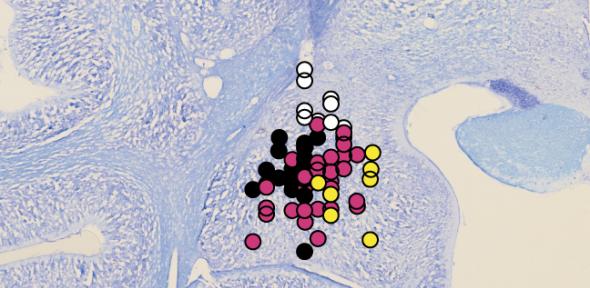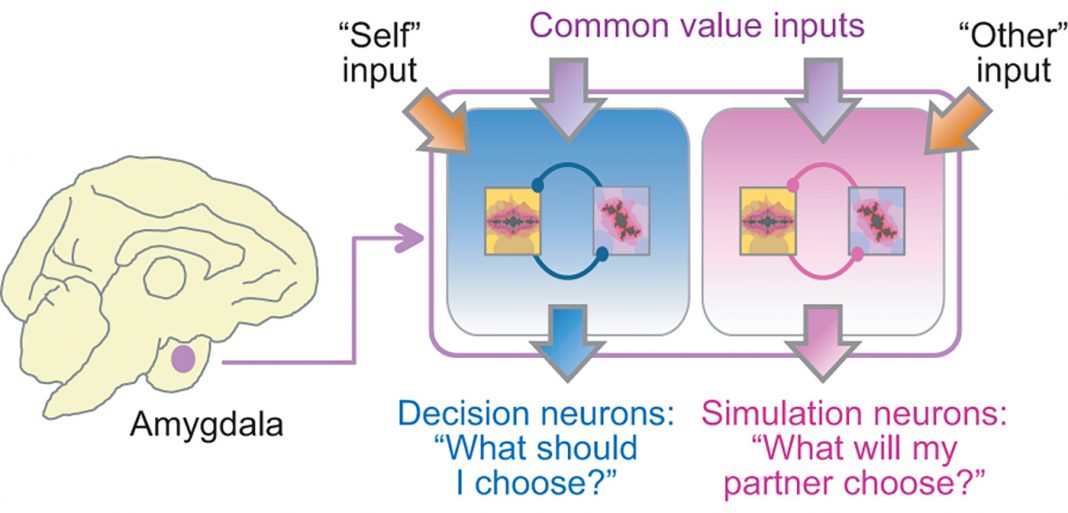Collaborating scientists in the U.K. and Spain have identified a previously unknown type of neuron in the amygdala region of primate brains that can simulate decision-making processes occurring in others, effectively allowing one rhesus monkey to reconstruct the state of mind of another and predict their intentions. The researchers, headed by Fabian Grabenhorst, PhD, at the University of Cambridge, U.K., suggest that dysfunction in such “simulation neurons” may be linked with social difficulties experienced by people with conditions such as autism and social anxiety.
“We started out looking for neurons that might be involved in social learning,” said Grabenhorst, a researcher at the department of physiology, development, and neuroscience. “We were surprised to find that amygdala neurons not only learn the value of objects from social observation but actually use this information to simulate a partner’s decisions.” The researchers reported their discoveries in Cell, in a paper titled, “Primate amygdala neurons stimulate decision processes of social partners.”
The ability to simulate decisions made by others is a sophisticated cognitive process that is rooted in social learning, the authors explained. For example, primates observe the choices made by other members of their group to learn about the reward value of objects. What individuals can learn from such observations helps to instruct their own decision making, but can also help them to predict other individuals’ decisions. “For example, by observing partners’ foraging choices, primates learn which foods are valuable and worth choosing,” the scientists wrote. “In turn, knowing how a partner values specific objects may help the observer to model the partner’s future decisions.”
Psychologists reason that humans also use simulation as a mechanism to help understand each other’s minds, but the neurological workings that underpin this complex process aren’t well understood. One region of the brain that may be involved is the amygdala, which plays diverse roles in social behavior, and has also been implicated in autism, the researchers continued. However, it’s not known whether neurons in the amygdala may also contribute to more advanced social cognition, such as simulating others’ decisions. “Although the amygdala’s role in social behavior is typically explained in terms of associative learning and social perception, whether amygdala neurons also contribute to more complex social cognition is unclear,” they wrote.
To investigate this in more detail the team recorded the activity of individual amygdala neurons in rhesus monkeys, in a social context, which involved placing the monkeys in a situation in which they observed and learned from each other’s reward-based choices. The animals were sat facing each other with a touch screen between them, and took turns making choices to obtain a fruit juice reward. To maximize the reward the animals needed to learn and track the reward probabilities linked to different pictures displayed on the screen. One animal was allowed to observe its partner’s choices, and learn the reward values of the pictures displayed to them. When the roles were reversed, the animal that had previously been the observer was able to use what it had learned to inform its own choices.
The results indicated that a specific type of neuron in the amygdala of an observing animal could actively simulate the partner’s decision-making processes. The observer’s amygdala neurons were effectively carrying out decision computations, first comparing the reward values of the partner’s choice options and then signaling the partner’s likely choice. These neuronal activity patterns were played out spontaneously, well before the partner’s choices, and even though the observer didn’t need to make a decision. “These data show that when monkeys observe and learn from each other’s choices, amygdala neurons derive object-specific reward values from social observation, and dynamically convert these values to representations of the partner’s forthcoming choices,” the researchers wrote.

“We found that amygdala neurons encoded object-specific values learned from social observation and own experience in a common code, as suitable decision inputs,” the authors wrote. “Distinct ‘simulation neurons’ dynamically translated these values into representations of the partner monkey’s forthcoming choices. Beyond choice predictions, these neurons encoded the critical well-conceptualized signatures of a neuronal decision computation, specifically before the partner’s (but not recorded monkey’s) decisions.”
“Simulation and decision neurons are closely intermingled within the amygdala,” Grabenhorst stated. “We managed to distinguish between them and their different functions by carefully examining one neuron at a time. This would not have been possible with human brain imaging techniques that measure the averaged activity of large numbers of neurons.”
The researchers say their results also link prior work on the functions of amygdala neurons in decision making, to the amygdala’s well-known role in social behavior and implicated role in autism and other conditions characterized by atypical social cognition, such as social anxiety. Dysfunction of the simulation neurons or their inputs could hamper social behavior by reducing an individual’s ability to relate to the mental states of others, while lack of neuronal stimulation by the amygdala could “play a role in the poor social communication capabilities of some individuals with autism.” Conversely, hyperactivity of the amygdala neurons might “exaggerate spontaneous simulation of others’ mental processes,” which could lead to symptoms typical of social anxiety, the authors commented. “The amygdala simulation neurons reported here could allow primates to reconstruct their social partner’s mental states and may constitute simple precursors for human mentalizing capacities, such as theory of mind.”
“We know very little about how specific neuron types contribute to social cognition and to the social challenges faced by individuals with autism,” Grabenhorst stated. “By identifying specific neurons and circuit mechanisms for mental simulation, our study may offer new insights into these conditions.”



